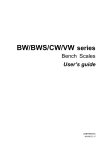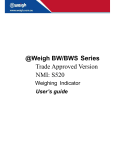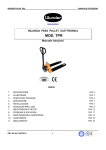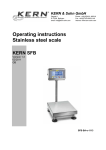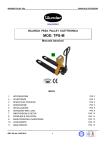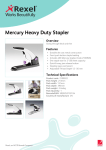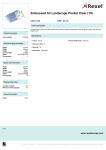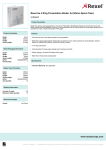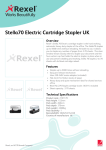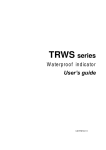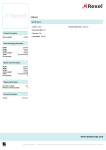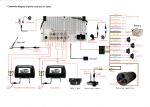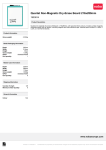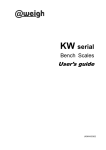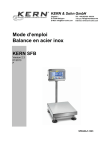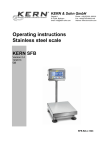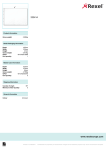Download BW/BWS-E series
Transcript
BW/BWS-E series Indicator Scales User’s guide BW/BWSE v1.03 BW/BWS-E serial Indicator user’s manual Table of Contents SECTION 1 INTRODUCTION…………………………………………………….………1 SECTION 2 SPECIFICATIONS………………………………………………….…..……2 SECTION 3 INSTALLATION……………………………………………………………….3 3. 1 General installation…………………………………………………………….………3 3. 2 Installation of BW/BWS-E series…………………………………………….3 3. 3 Port connect……………………………………………………………….……………4 3.3.1 Port location……………………………………………………………….…………..4 3.3.2 Load cell port…………………………………………………………….….…………5 3.3.3 RS-232…………………………………………………………………………………5 3.3.4 Analog output and check weighing output………………………………………….5 3.3.5 Mercury level bubble…………………………………………………………………6 SECTION 4 KEY DESCRIPTIONS………………………………………….……………7 SECTION 5 DISPLAYS…………………………………………………………………….8 SECTION 6 OPERATION…………………….……………………………….……….…..9 6.1 Zeroing the display…………………………………………………………….……….9 6.2 Taring……………………………………………………………………………....…….9 6.3 Weighing a sample…….………………………………………………….…………….9 6.4 Check-weighing………………………………………………………………………….9 6.4.1 About check weighing……………………………………………..………………….9 6.4.2 Set limit………………………………………………………………..……………10 6.4.3 Set check weighing mode…………………………………………………………10 6.4.4 Note………………………………………………………………………….………..10 6.5 Accumulated total……………………………………………………………………10 6.5.1Note……………………………………………………………………………………10 6.5.2 Accumulate operate………………………………………………………..………10 6.5.3 Memory recall……………………………………………………………..…………11 6.5.4 Memory clear……………………………………………………………..…………11 6.5.5 Automatically accumulate…………………………………………………………..11 6.6 animal …………………………………………………………………………….11 6.7 keyboard lock…………………………………………………………………………..11 6.8 set auto power off ……………………………………………………………………..11 SECTION 7 PARAMETERS………………………………………………………………12 SECTION 8 BATTERY OPERATION…………………………………………..……..…16 SECTION 9 RS-232 OUTPUT…………………………………………………..………..17 9.1 basic information……………………………………………………………….………17 9.2 normal output……………………………………………………………………..……17 9.3 continuously output protocol…………………………………………………….……17 SECTION 10 CALIBRATION……………………………………..……………….……..18 SECTION 11 ERROR CODE…………………………………….………………………20 -I- BW/BWS-E serial Indicator user’s manual SECTION 1 INTRODUCTION The BW/BWS-E series of indicator provides an accurate, fast and versatile series of general purpose weighing scale with counting and check-weighing functions. There are 3 series s within the range, the platform size from 350mm x 450mm to 600mm x 800mm, the capacity range from 30kg to 1000kg All the displays are large easy to read liquid crystal type displays (LED) All units include automatic zero tracking, audible alarm for pre-set weights, and an accumulation facility that allows the individual weights to be stored and recalled as an accumulated total. -1- BW/BWS-E serial Indicator user’s manual SECTION 2 SPECIFICATIONS Model SBW/BWS-E MBW/BWS-E LBW/BWS-E Platform size 350mm x 450mm 420mm x 520mm 600mm x 800mm Capacity 30kg/60kg/150kg 60kg/150kg/300kg 300kg/600kg/1000kg Resolution 1:15.000 Interface RS-232 Output Optional Analog Output Optional Stabilisation Time 1 Seconds typical Operating Temperature 0°C - 40°C / 32°F - 104°F Power supply External AC adapter, 9V 800mA AC powered, 115V/230V Calibration Automatic External Display 1.2’’ LED Balance Housing Indicator ABS Plastic / SST Load cell drive voltage Max 5V/150mA Load cells Up to four 350 ohms cells -2- BW/BWS-E serial Indicator user’s manual SECTION 3 INSTALLATION 3. 1 GENERAL INSTALLATION The s should be sited in a location that will not degrade the accuracy. Avoid extremes of temperature. Do not place in direct sunlight or near air conditioning vents. Avoid unsuitable tables. The tables or floor must be rigid and not vibrate. Do not place near vibrating machinery. Avoid unstable power sources. Do not use near large users of electricity such as welding equipment or large motors. Avoid high humidity that might cause condensation. Avoid direct contact with water. Do not spray or immerse the s in water. Avoid air movement such as from fans or opening doors. Do not place near open windows. Keep the s clean. Do not stack material on the s when they are not in use. 3. 2 INSTALLATION OF BW/BWS-E SERIES The pillar is attached to the base using a bracket that must first be attached to the base frame using the 4 bolts supplied. The Pillar is secured to the bracket using 2 set screws. The cable from the base to the indicator module is run through the tube, out through the plastic support at the top. Excess cable can be stored within the tube. The BW/BWS-E Series comes with a stainless steel platform packed separately. Place the platform in the base. Level the scale by adjusting the four feet. The scale should be adjusted such that the bubble in the spirit level is in the center of the level and the scale is supported by all four feet. If the scale rocks read just the feet. Attach the indicator module to the pillar by sliding it over the bracket with the flanges engaged in the groves on the base. Attach the cable from the base to the connector on the rear of the indicator. Attach the AC power adapter to the connector on the back of the indicator. -3- BW/BWS-E serial Indicator user’s manual 3. 3 PORT CONNECTION 3.3.1 port locations BW/BWS-E (rear side) Analog output Load cell RS-232 AC adapter AC power socket For pole neck BWS (Under Side) Analog output AC adapter Load cell -4- RS-232 BW/BWS-E serial Indicator user’s manual 3.3.2 load cell port Load cell connect as below( 5pin air connecter) EXC+ SEN+ SIG+ LOAD CELL 5 5 3 2 4 4 1 SIG- SENSHIELD EXC- 3.3.3 RS-232 RS-232 (Air connector / D type connector) 2 RXD Input Receiving data 3 TXD Output Transmission data 5 GND ― Signal ground 3.3.4 Analog output and check weighing output 9 pin air connector pin1~pin6: check weighing output pin 1 hi (output) pin 2 ok (output) pin 3 low (output) pin 4 beep (output) pin 5 vcc (5V)(output) pin 6 com (gnd) -5- BW/BWS-E serial Indicator user’s manual pin6~pin9 analog output pin 6 com (gnd) pin 7 analog power input (10~32VDC, +) (input) pin 8 T+ (0~10V/4~20mA) (output) pin9 T- (0~10V/4~20mA) (output) Check weighing output application sample (you need a additional output control PCBA) BW/BWS-E indicator Output control PCBA J1 AC power L N 3.3.5 Mercury level bubble If you want to scale can’t work when not level, you can add one mercury level bubble, connect 2 wire to K1, when scale not level, mercury level bubble short, indicator will show “err l”, when this message appear, please adjust scale level. If you don’t need this function, just leave K1 unused. -6- BW/BWS-E serial Indicator user’s manual SECTION 4 KEY DESCRIPTIONS ON/ OFF or Turn on or off the power. Zero Set the zero point for all subsequent weighing. The display shows zero. A secondary function of "Enter" key when set parameters or other functions. Tare Stores the current weight in memory as a tare value, subtracts the tare value from the weight and shows the results. A secondary function incrementing the active digit when set a value for parameters or other functions. Press Zero and Tare key together in normal weighing mode will turn on/off animal function. (When enter/escape animal mode, you will hear beeper on twice) MR Memory recall key, show total accumulate weight in memory. In setting mode, this key used to move active digits right. M+ Accumulate key, store current weight in memory. In setting mode, this key used to move active digits left. Press M+ and MR key for MC (memory clear) Print For print the results to a PC or printer using the optional RS-232 interface. Press Print during self checking will enter setting mode. G/N Gross weight/net weight shift key, Hold this key for 3 seconds to shift the unit. Secondary function (ESC) , is to return to normal operation when the mode is in a parameter setting mode. Press G/N and Print key together for setting check Weighing limit. -7- BW/BWS-E serial Indicator user’s manual SECTION 5 DISPLAYS The LED display will show a value. In addition there are LED lights for Zero, Stable, Tare, Batt, Kg, U2. -8- BW/BWS-E serial Indicator user’s manual SECTION 6 OPERATION 6.1 Zeroing The Display You can press the ZERO key at any time to set the zero point from which all other weighing and counting is measured, within 4% of power up zero. This will usually only be necessary when the platform is empty. When the zero point is obtained the display will show the indicator for zero. The scale has an automatic rezeroing function to account for minor drifting or accumulation of material on the platform. However you may need to press the ZERO key to rezero the scale if small amounts of weight are shown when the platform is empty. 6.2 Taring Zero the scale by pressing the ZERO key if necessary. The zero indication will be on. Place a container on the platform, a value for its weight will be displayed. Press the TARE key to tare the scale. The weight that was displayed is stored as the tare value and that value is subtracted from the display, leaving zero on the display. The "NET" indicator will be on. As product is added only the weight of the product will be shown. The scale could be tared a second time if another type of product was to be added to the first one. Again only the weight that is added after taring will be displayed. When the container is removed a negative value will be shown. If the scale was tared just before removing the container this value is the gross weight of the container plus all product that was removed. The zero indicator will also be on because the platform is back to the same condition it was when the ZERO key was last pressed. 6.3 Weighing a sample To determine the weight of a sample first tare the empty container then place the sample in the container. the display will show the weight and the units of weight currently in use. 6.4 Check-Weighing 6.4.1 About check-weighing Check-weighing is a procedure to cause an alarm to sound when the weight on the meets or exceeds values stored in memory. The memory holds values for a high limit and a low limit. -9- BW/BWS-E serial Indicator user’s manual Check mode OK: When check range, the display will show OK and the beeper will sound when the weight is between the limits. Check mode NG: When check range, the display will show OK and the beeper will sound when the weight is out of the limits. 6.4.2 Set limits Press G/N and PRINT key together, it will display “set h”, use TARE key to select “SET H” or “SET L”, press ZERO key to enter, use M+ and MR key to move active digit, use TARE key to change value, use Print key to clear value. After you enter the value, press ZERO key to sure, press G/N key to escape. 6.4.3 Set check weighing mode Press G/N and print key together, it will display “set h”, use TARE key to select beep, press ZERO key to enter, press TARE key to select ok(check mode OK), ng (check mode NG), no(no beep), press ZERO key to sure, press G/N key to escape. 6.4.4 NOTE Check weighing function only available when weight more than 20d (min). To disable the Check-Weighing function enter zero into both limits by pressing the PRINT key when the current limits are shown then pressing ZERO/ENTER to store the zero values. 6.5 Accumulated Total 6.5.1 Note The scale can be set to accumulate manually by pressing the M+ key. See the PARAMETERS Section for details of selecting the method using function "P2 com". Please note before every accumulate operate, scale need return to zero, and only press M+ key when stable, when weight less than 20d, accumulate operate will be invalid. 6.5.2 Accumulate operate The weight displayed will be stored in memory when the M+ key is pressed and the weight is stable. The display will show "ACC 1" and then the total in memory for 2 seconds before returning to normal. (after do accumulate operate, “M+” indicator will turn on) If the optional RS-232 interface is installed the weight will be output to a printer or PC. Remove the weight, allowing the scale to return to zero and put a second weight on. Press the M+ key, the display will show "ACC 2" and then the new total. - 10 - BW/BWS-E serial Indicator user’s manual Continue until all weights have been added. 6.5.3 memory recall To view the totals in memory press MR key. 6.5.4 memory clear To clear the memory, just press M+ and MR together 6.5.5 automatically accumulate Press Print key during self checking, enter setting mode, press Tare key until display show P32COM, press ZERO key to enter, press TARE key to select “mode”, press ZERO key to sure, display will show current RS-232 mode, press TARE key to select Auto. After you set, AUTO indicator on. Press weight on platform, after stable, you will hear beep on twice, you can add or remote weight now, scale will beep on again after stable, at last, remove all weight on platform, the last weight value will store in memory 6.6 Animal s Let the animal on the platform, after some second, if reading data change not a lot, you can hear beep sound and reading data will be locked. In reading data lock mode, if you add/remove big weight, display will still update and lock new reading data. You can press ZERO TARE together to enter/escape animal weighing mode. 6.7 Keyboard lock You can use keyboard lock when this function enable (see detail setting process in section 7), after keyboard haven’t use for 10 minutes, keyboard will be lock, after enter lock status, if you press any key, display will show “K-LCK”. If you want to escape lock mode and return work mode, hold PRINT , MR , ZERO key 2 seconds, display will show “ULCK”, return normal mode. 6.8 set auto power off Hold ZERO key 3 second, display will show ”setbl “, press ZERO key to enter. press TARE key, display show “setoff”, press ZERO key to enter auto power off setting, press TARE key to change auto power off time:0ff/on/3/5/15/30. (of ON: always on, of off: always off, of xx: auto power off after standby xx minutes), press ZERO key to sure, press G/N key to escape. - 11 - BW/BWS-E serial Indicator user’s manual SECTION 7 PARAMETERS The scale has 5 parameters that can be set by the user plus a method of entering the calibration section. To set parameters press the PRINT key during self checking, display will show pn (ask password), press M+, G/N, TARE to enter. The display will show the first function, "p0 chk". Pressing the TARE key will cycle through the other functions. Pressing ZERO will allow you to set the function. It may be necessary to either use TARE or set a value using the M+ MR key to move the active digit and then using the TARE key to increment a digit, followed by the ZERO key to enter the value. Use the G/N key to leave a parameter unchanged. For example when the display shows “p0 chk” press the ZERO key to begin. The display will show “Set Lo”, press the ZERO key to set the low limit, or press the TARE to skip to the next parameter, “Set Hi” for setting the high limit. After pressing the ZERO key to set a limit, use the M+ MR keys to change the flashing digit, then use the TARE key to increment the flashing digit. Continue to the next digit and set it as needed. When all digits have been set press the ZERO key to store the value. The display will go back to the parameter just set, i.e. “Set Lo”. Advance to another parameter if needed or press the G/N key to return to weighing. Parameter setting table functio n P0 CHK Sub function SET H SET LO BEEP P1 REF AZN 0 0AUTO - 12 - describe Set high limit, press M+ MR key to move active digit, press TARE to change value, press PRINT key to clear data, press ZERO key to sure. Set high limit, press M+ MR key to move active digit, press TARE to change value, press PRINT key to clear data, press ZERO key to sure. Set beep mode, no: no beep for check Weighing OK: beep when weight between hi and low (OK) ng: beep when weight out of hi-low range (NG) This option is used to select the auto zero tracking range Options : 0.5d, 1d, 2d, 4d This option is used to select the auto zero range when turn the indicator. Options : 0%, 2%, 5%, 10%, 20%, 50%, 100% BW/BWS-E serial Indicator user’s manual 0RAGE This option is used to select the manual zero range when press the ZERO key. Options: 0%, 2%, 4%, 10%, 20%, 50%, 100% This option is used to set whether Bench Scales will do auto zero tracking in net mode (after do tare operate, net weight is zero) Options: ON/OFF Set the ADC speed 7.5/15/30/60 times/second Set new zero point, after set this value, when in zero point, the reading will be –xxx.xxx This option is used to set RS-232 communication mode Options: CONT(continuously send) ST1: send one frame data after stable STC: send data continuously when stable PR1: when press print key, send one frame data (printer mode) PR2: when press M+ key, do print data and M+ at the same time AUTO: auto accumulate (auto print) mode, when weight stable and then return to zero, indicator will do accumulate and print operate automatically ASK: ask mode, bi-direction, Command R: read data Command T: tare Command Z: zero Wireless: wireless mode Note: if you have selected the wireless model, the communication mode has to be set to wireless. This option is used to set baud rate Options: 600/1200/2400/4800/9600 This option is used to set parity verify Optional: 7E1/7O1/8N1 0-TARE SPEED ZERO P2 COM MODE BAUD pr ptype P3 Lin lab tpup: set the printer as tpup model. lp-50: set the printer as LP-50 model. “Lab x”, set gross/acc print format prt “prt, set the date/time print format DECI This option is used to select the decimal Options : 0, 0.0, 0.00, 0.000 This option is used to select the division Options : 1, 2, 5, 10, 20, 50, 100, 200 This display will show xxxxxx for setting the capacity. Nonlin Non- linearity Calibrate Liner Linearity Calibrate This display will show xxxxxx for indicating the internal counts. Enable /disable key lock Dual ON/ OFF INC CAP CAL COUNT P4 LOCK - 13 - BW/BWS-E serial Indicator user’s manual OTH ANM P5 unt Kg/ Lb/ L2/ tj/ hj P6 Cal ON (animal ) OFF(normal mode) Set unit, when the unit is set for U2, then this unit could be active to U2. Note: lb, oz, Tj and Hj could not be used at the same time. If you select U2, then will get kg and which you select secondary unit. External calibration. Form one LAB TYPE 1 2 3 tpup tpup tpup GS: 0.888kg NT: 0.666kg TW: 0.222kg GW: 0.888kg GS: 0.222kg TOTAL: 0.222kg 1 DATE: 04/06/06 GS: 0.888kg DATE: 04/06/06 NT: 0.666kg TW: 0.222Kg GW: 0.888kg DATE: 04/06/06 GS: 0.222kg TOTAL: 0.444kg 2 TIME: 11/11/11 GS: 0.888kg TIME: 11/11/11 NT: 0.666kg TW: 0.222kg GW: 0.888kg TIME: 11/11/11 GS: 0.222kg TOTAL: 0.666kg 3 DATE: 04/06/06 TIME: 11/11/11 GS: 0.888kg DATE: 04/06/06 TIME: 11/11/11 NT: 0.666kg TW: 0.222kg GW: 0.888kg DATE: 04/06/06 TIME: 11/11/11 GS: 0.222kg TOTAL: 0.888kg 4 NO.: GS: NO. : 4 NT : 0.666kg TW: 0.222kg GW: 0.888kg NO.: 4 GS: 0.222kg TOTAL: 1.000kg 5 DATE: 04/06/06 NO.: 5 GS: 0.888kg DATE: 04/06/06 NO.: 5 NT: 0.666kg TW: 0.222kg GW: 0.888kg DATE: 04/06/06 NO.: 5 GS: 0.222kg TOTAL: 1.222kg 6 TIME: 11/11/11 NO.: 6 GS: 0.888kg TIME: NO.: NT: TW: GW: TIME: 11/11/11 NO.: 6 GS: 0.222kg TOTAL: 1.444kg DATE: 04/06/06 TIME: 11/11/11 NO.: 7 GS: 0.888kg DATE: 04/06/06 TIME: 11/11/11 NO.: 7 NT: 0.666kg TW: 0.222kg GW: 0.888kg NT: 0.222kg TW: 0.666kg GW: 0.888kg TOTAL: 0.222kg DATE: 04/06/06 NT: 0.222kg TW: 0.666kg GW: 0.888kg TOTAL: 0.444kg TIME: 11/11/11 NT: 0.222kg TW: 0.666kg GW: 0.888kg TOTAL: 0.666kg DATE: 04/06/06 TIME: 11/11/11 NT: 0.222kg TW: 0.666kg GW: 0.888kg TOTAL: 0.888kg No.: 4 NT: 0.222kg TW: 0.666kg GW: 0.888kg TOTAL: 1.000kg DATE: 04/06/06 No.: 5 NT: 0.222kg TW: 0.666kg GW: 0.888kg TOTAL: 1.222kg TIME: 11/11/11 No.: 6 NT: 0.222kg TW: 0.666kg GW: 0.888kg TOTAL: 1.444kg DATE: 04/06/06 TIME: 11/11/11 No.: 7 NT: 0.222kg TW:: 0.666kg GW: 0.888kg TOTAL: 1.666kg PRT 0 7 - 14 - 0 tpup 4 0.888kg 11/11/11 6 0.666kg 0.222kg 0.888kg DATE: TIME: NO.: GS: TOTAL: 04/06/06 11/11/11 7 0.222kg 1.666kg BW/BWS-E serial Indicator user’s manual Form two LAB PRT TYPE 0 1 2 3 4 5 6 7 0 LP-50 2000/00/00 00:00 S/N 1 GW 0.888kg DATE: 2000/00/00 TIME: 00:00 GW: 0.888kg DATE: TIME: 00:00 S./NO.: 2 GROSS WT: 0.888kg 2000/00/00 00:00 S/N 0003 GW 0.888kg 2000/00/00 00:00 S/N 4 GW 0.888kg DATE: 2000/00/00 TIME: 00:00 GW: 0.888kg DATE: TIME: 00:00 S./NO.: 6 GROSS WT: 0.888kg 2000/00/00 00:00 S/N 7 GW 0.888kg 1 2 3 LP-50 left As left As LP-50 left As left As left As left As left As left As left As left As left As left As left As left As left As left As left As left As left As left As left As left As left As left As LP-50 - 15 - BW/BWS-E serial Indicator user’s manual SECTION 8 BATTERY OPERATIONS The indicator can be operated from the battery if desired. The battery life is approximately 70 hours. When the battery needs charging a symbol on the weight display will turn on. The battery should be charged when the symbol is on. The scale will still operate for about 10 hours after which it will automatically switch off to protect the battery. To charge the battery simply plug into the mains power. The scale does not need to be turned on. The battery should be charged for 12 hours for full capacity. Just left side of the display is an LED to indicate the status of battery charging. When the scale is plugged into the mains power the internal battery will be charged. If the LED is green the battery has a full charge. If it is Red the battery is nearly discharged and yellow indicates the battery is being charged. As the battery is used it may fail to hold a full charge. If the battery life becomes unacceptable then contact your distributor. - 16 - BW/BWS-E serial Indicator user’s manual SECTION 9 RS-232 OUTPUT The BW/BWS-E Series of s can be ordered with an optional RS-232 output. 9. 1 basic information Specifications: RS-232 output of weighing data ASCII code 7/8 data bits Parity stable Baud rate from 600bps to 9600bps Connector: 9 pin d-subminiature socket / 9 pin air connector Pin 2: Input, Pin 3: Output Pin 5: Signal Ground 9. 2 normal print out Data Format for normal weighing operations, parts counting or recalling of totals from memory will all be different. Examples follow: Normal Output S/N GW The number increments every time a new value is stored in memory GW for gross weight, NT for net weight and a unit of weight <If> <If> Includes 2 line feeds When recalling the Total weight stored in the accumulation memory the output format is: *************** <lf> Total No: 3 Total wt.: 0.447KG *************** A line of stars is shown Includes 1 line feed Times of the accumulation memory Weight of the accumulation memory 9. 3 continuously output protocol con1: weighing mode k -HEADER1-- - HEADER2- --- WEIGHT DATA -- g CR LF -WEIGHT UNIT- TERMINATOR HEADER1: ST=STABLE US=UNSTABLE HEADER2: NT=NET GS=GROSS - 17 - BW/BWS-E serial Indicator user’s manual SECTION 10 CALIBRATION Turn the power off. Turn the power back on, during the counting from 9 to 0 press the PRINT key. The display will show "pn " (ask password), press M+, G/N, TARE to enter. The display will show the first function, "p0chk". , press TARE until display show P3 Lin, press zero to enter, press Tare to select CAL, press ZERO key to enter calibrate. The display will show "Nonlin". 1. Normal calibrate press ZERO key to enter calibrate. The display will show "unLd". Remove any weight from the platform. key. After stable indicator on, press the ZERO Then the display will show the last calibration weight used. If this is correct you can continue by pressing the ZERO key. If it is not correct use the M+, MR, TARE keys to change the calibration weight value. When will correct, press the ZERO key. Then display will show "LoAd". Place the calibration weight on the scale. After stable, press the ZERO key. 2. Linearity Calibrate Press ZERO key to enter calibrate. Press TARE key. Then the display will show Liner ". " Press ZERO key to enter calibrate. Then the display will show ”PIN”, (ask password), press G/N, M+ , MR to enter. The display will show "Load0". Remove any weight from the platform. key. After stable indicator on, press the ZERO Then the display will show "Load1", apply the reference weight of the full capacity of the scale just in the center of the platform. The span adjustment will automatically be achieved.(Calibrate weight request: the front digits if the full capacity. For example, the full capacity is 300kg, the 30kg/40kg/… to 290kg (integer value) ) will be accepted. then press the ZERO key. - 18 - BW/BWS-E serial Indicator user’s manual Then the display will show "Load2", apply the reference weight of the full capacity of the scale just in the center of the platform. The rule is the same as "Load1". then press the ZERO key. Then the display will show "Load3", apply the weight of the full capacity, the full capacity will automatically be achieved. then press the ZERO key. If the calibration is acceptable the display will return to normal. If an error message is shown try calibration again as a disturbance may have prevented a successful calibration. 3. External Calibrate press TARE until display show P6 Cal, then press ZERO key to enter external calibrate. The display will show "unLd". Remove any weight from the platform. key. After stable indicator on, press the ZERO Then the display will show the last calibration weight used. If this is correct you can continue by pressing the ZERO key. If it is not correct use the M+, MR, TARE keys to change the calibration weight value. When will correct, press the ZERO key. Then display will show "LoAd". Place the calibration weight on the scale. After stable, press the ZERO key. Note, only after the linearity calibrate has been completed, then the external calibrate could be set. If the problem persists then contact your dealer. After calibration, it should be checked to verify the calibration and linearity is correct. If necessary repeat calibration, especially be certain the scale is stable before accepting any weight. - 19 - BW/BWS-E serial Indicator user’s manual SECTION 11 ERROR CODES Error Message ----Err 1 Description Maximum load exceeded Incorrect date Err 2 Incorrect time Err 4 Zero setting error Err 5 Err 6 Key board error A/D value out of range Err 9 Unstable Reading Err 17 --ol-- Tare out of range Over range Fai l h / fai l l Err p Ba lo / lo ba Calibration Error Remove the load and restart scale again. Remove the load. Re calibrate Re calibrate Printer error Battery low Check the printer and settings Re charge battery, check the voltages. - 20 - Solution Unload or reduce weight Enter the date by using format “yy;mm:dd” Enter the time by using format “hh:mm:ss” Zero setting range exceeded due to switching on.(4%max) Make sure platform empty. Check the keys and connecter. Make sure platform empty and check the pan is installed proper. Check the load cell connectors. Check any air variation, vibration, RF noise and touching some where. Check the load cell and connecters.
























